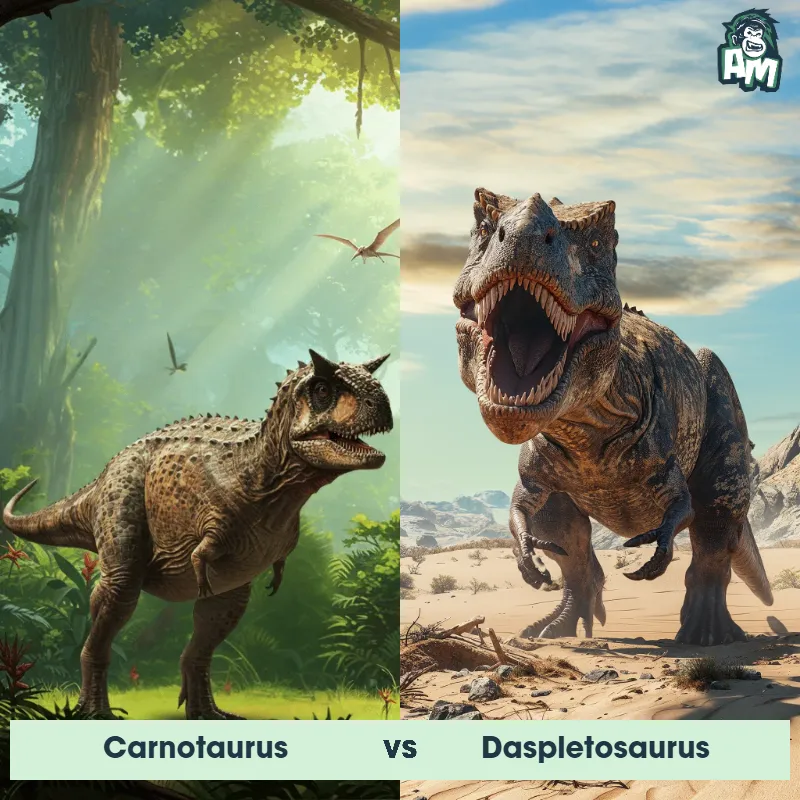The Daspletosaurus
Daspletosaurus, also known as the "frightful lizard," was a large carnivorous dinosaur that roamed North America during the Late Cretaceous period. It was a close relative of the infamous Tyrannosaurus rex, with a similar appearance featuring a massive skull filled with sharp teeth, powerful jaws, and strong hind legs for hunting. Daspletosaurus had small arms with two-fingered hands and a robust body supported by a long tail.

| Daspletosaurus | |
|---|---|
| Size | 30 feet (9 meters) |
| Weight | 2.5 tons (2,268 kilograms) |
| Speed | 20-25mph (32-40 km/h) |
| Key Strength | Powerful jaws and sharp teeth |
| Biggest Weakness | Relatively small forelimbs |
| Scientific Name | Daspletosaurus |
| Family | Tyrannosauridae |
| Habitat | Woodlands and plains |
| Geography | North America |
| Diet | Carnivorous |
| Lifespan | 20 years - 30 years |

The Daspletosaurus
Daspletosaurus, also known as the "frightful lizard," was a large carnivorous dinosaur that roamed North America during the Late Cretaceous period. It was a close relative of the infamous Tyrannosaurus rex, with a similar appearance featuring a massive skull filled with sharp teeth, powerful jaws, and strong hind legs for hunting. Daspletosaurus had small arms with two-fingered hands and a robust body supported by a long tail.
Fun Fact: Daspletosaurus is believed to have been one of the top predators in its ecosystem, displaying aggressive behavior and likely hunting other large dinosaurs for food.
| Daspletosaurus | |
|---|---|
| Size | 30 feet (9 meters) |
| Weight | 2.5 tons (2,268 kilograms) |
| Speed | 20-25mph (32-40 km/h) |
| Key Strength | Powerful jaws and sharp teeth |
| Biggest Weakness | Relatively small forelimbs |
| Scientific Name | Daspletosaurus |
| Family | Tyrannosauridae |
| Habitat | Woodlands and plains |
| Geography | North America |
| Diet | Carnivorous |
| Lifespan | 20 years - 30 years |
Daspletosaurus Matchups
We use AI to simulate matchups between the Daspletosaurus and other animals. Our simulation considers size, strength, and natural predatory behaviors to determine the most likely outcome.

Can't find the Matchup you want?
Create Your Own MatchupDaspletosaurus: Diet, Predators, Aggression, and Defensive Behaviors
What did Daspletosaurus eat?
Daspletosaurus were carnivorous dinosaurs that primarily fed on large herbivorous dinosaurs such as ceratopsids and hadrosaurs. Their diet also likely included other small to medium-sized dinosaurs and possibly carrion.
Did Daspletosaurus have any predators?
As apex predators themselves, adult Daspletosaurus would not have had many natural predators. However, younger or weaker individuals may have been vulnerable to larger theropods or other carnivorous dinosaurs.
Were Daspletosaurus aggressive?
Daspletosaurus were known to be aggressive predators, using their size, strength, and sharp teeth to take down their prey. They were likely territorial and may have competed with each other for food or mating rights.
Did Daspletosaurus fight?
Daspletosaurus likely engaged in territorial disputes or battles for dominance, especially during the mating season. These fights may have involved biting, clawing, and using their powerful tails to inflict damage on rivals.
How did Daspletosaurus defend themselves?
To defend themselves against potential threats or attacks, Daspletosaurus likely relied on their size, strength, speed, and formidable weaponry such as their sharp teeth and clawed hands. They may have also used their intelligence and hunting skills to outmaneuver or outsmart their adversaries.
What was Daspletosaurus' biggest weakness in a fight?
Despite their impressive physical attributes, Daspletosaurus' biggest weakness in a fight may have been their limited agility and endurance compared to more nimble predators. Their size and weight could make them vulnerable to faster or more agile foes that could exploit their slow movements or stamina.
Fun Fact: The name "Daspletosaurus" translates to "frightful lizard," emphasizing the intimidating nature of this dinosaur and its role as a fearsome predator in its environment.
Fun Fact: Despite its formidable size and strength, Daspletosaurus belonged to the tyrannosaurid group, which included some of the largest and most powerful predators of the Late Cretaceous period.










